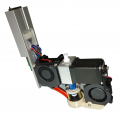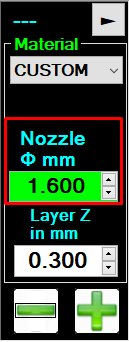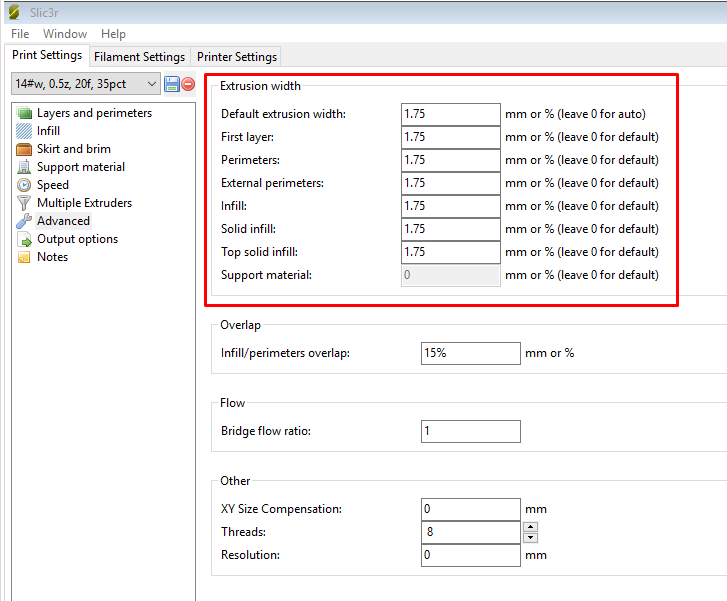Filament Heads
Contents |
Filament heads are how we print (using FFF or FDM) with filament-based materials which are deposited at over 150°C, depending on the head.
Note that at present, our Filament heads work with 1.75mm filament (actually, 1.6mm to 1.9mm), but not 3mm filament.
Materials for Filament Heads
The following materials can be printed from Filament heads.
- ABS (Acrylonitrile Butadiene Styrene)
- Flame Retardant ABS
- ABS - PC Alloy
- Conductive ABS
- Smart ABS
- BendLay
- Flex 45
- HIPS (High-Impact PolyStyrene)
- LayBrick
- LayWoo-d3
- MoldLay
- Ninjaflex
- Nylon
- Taulman 618, 645, 910
- PC (PolyCarbnoate)
- PEI (PolyEtherImide) - AKA Ultem
- PEEK (PolyEther Ether Ketone)
- PET (PolyEthylene Terephthalate)
- PETG PolyEthylene Terephthalate Glycol-modified)
- PLA (PolyLactic Acid)
- EcoFlex PLA
- Conductive PLA
- SS PLA (Stainless Steel infused)
- PlastInk_Rubber
- PP (PolyPropylene)
- PVA (PolyVinyl Alcohol)
- T-Glase
- Ultem
Filament Heads
Filament-based printing is available through the following heads:
Discontinued heads:
- General Filament Head Videos:
- MK1-250 Extruder for Standard Filament Videos:
- MK2-250 Extruder for Flexible Filament Videos:
- MK1-450 Extruder for High-Temperature Filament Videos:
Please see our Data Sheets as well.
Table of Filament Heads
The following table compares the properties of the various Filament heads, including which heads are recommended for which materials. The MK1 heads drive material from one side, with a spring-loaded bearing system to maintain pressure and positioning. The MK2 heads drive the material from both sides, and are designed for more flexible filaments.
| Head | Min Temp | Max Temp | Filament Type | Filament Size in mm |
Nozzle Type |
Nozzle Sizes in mm |
Recommended For | Description |
|---|---|---|---|---|---|---|---|---|
| FH2-260 high torque |
150°C | 250°C * 265°C |
Standard | 1.75 +/- 0.15 |
any m6 nozzle | standard options |
ABS, HIPS, LayBrick, LayWood, Nylon, PC, PET, PETG, PETT, PLA, PP, PVA, T-Glase | High Torque for Standard 1.75mm Filaments |
| FH2-450 high torque |
275°C | 450°C | Engineering | 1.75 +/- 0.15 |
any m6 nozzle | standard options |
PEEK, PEI (Ultem), PEKK, PPSU | High Torque for High Temperature 1.75mm Filaments |
Research Papers Citing Hyrel Filament
These are now listed by year here.
Firmware Versions for Filament Heads
Firmware information is listed on our Firmware page.
How do I change nozzles or clean nozzles?
Carefully:
- Heat to the printing temperature of the material loaded.
- Move the manual lever to the left, retracting material until it is free of the advancement gear, then remove by hand.
- Turn off heat to the head and remove it from the yoke. *Nozzle should be HOT when this step is done; use caution.
- With a 1/4" driver or wrench, remove the nozzle.
- Inspect the nozzle cavity for any stray material; if found, remove with tweezers, solvent, air pressure or other means.
- The old nozzle can be cleaned with a fine drill bit the same size as (or slightly smaller than) the nozzle diameter; some users also soak the nozzle in an appropriate solvent to remove all material.
- With a 1/4" driver or wrench, attach the new nozzle.
- Use normal procedure for heating and loading filament.
How do I change nozzle sizes?
There are two places where we consider nozzle size:
1. On the head, we use the number you have for nozzle diameter to make our flow calculations. See Flow Rate for details about how we determine how fast to spin the motor so that you get the proper volume per second of deposition. This image is for printing with a 14# (fourteen gauge, or 1.6mm ID) luer needle:
2. In the recipe, we use the extrusion width numbers to determine how far apart to place each bead of material. We expect your extrusion width to be 10% wider than your nozzle diameter (to allow for a nice sandbag-shaped cross section). This image is for printing with a 14# (fourteen gauge, or 1.6mm ID) luer needle:
This applies to everything we print, from PLA to Porcelain to PEEK.
Please note that we do NOT use any other variable relating to nozzle diameter. Not Bridge Flow Ratio. Not Nozzle Diameter. Not Extrusion Multiplier. All of these variables affect the E values in your gcode. Which we then ignore.
How do I load an Extruder onto the Printer
As with all Hyrel heads, the following process should be followed:
- Start with a level bed and Repetrel running and connected to the printer.
- Load the gibs on the Head into the gib slots on the Yoke from above and slide the head down into place; the last mm of travel should be done gently, ensuring that the electrical connector seats properly (firmly and completely) into the receiving connector.
- Ensure the LEDs on the print head are flashing - this means the Head is communicating with the Motion Controller.
- Tighten the thumbscrew in the rear, to prevent the head from moving relative to the Yoke.
- If the Head doesn't show up in Repetrel, press and release the RESET button on the front of the printer.
- Once the Head is shown in repetrel, proceed to setting your Z-Zero position.
See also: Loading Print Heads into your Hyrel 3D Printer
How do I load material into a Filament Head?
Filament heads all ship with a remaining piece of filament from the last test print (ABS, 240C for low-temp heads, and PEEK, 420C for high-temp heads. We recommend leaving a few cm of filament above the head when changing heads.
Unloading:
- With the head properly seated and the emergency stop OUT, warm the head to the service temperature of the presently loaded material.
- If presently loaded to a spool, press down on the blue pneumatic fitting and release the guide tubing; then cut the filament a few cm above the head.
- Press the manual feed lever (at the top left of the head's 103 circuit board) to the left, retracting the filament. Retract until the filament comes free of the motor shaft, then remove.
Loading:
- Straighten (if needed) the last few cm of the new filament, which should be routed through the guide tubing. Insert it down through the pneumatic fitting, into the PTFE guide tube, until it comes in contact with the motor shafts.
- Press the manual feed lever to the right, advancing the filament two to three cm.
- In repetrel, click the motor on at 500 (pulses per second) until the new filament advances to the melting zone and forces the old filament out. Advance about 30cm of filament, checking for smooth sides and uniform color.
- Remove excess filament with tweezers. Seat the guide tubing. You are ready to go.






